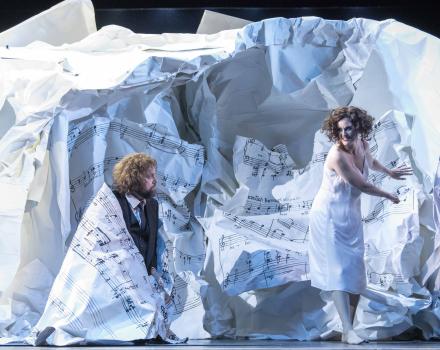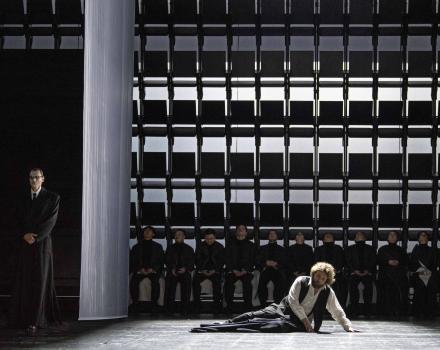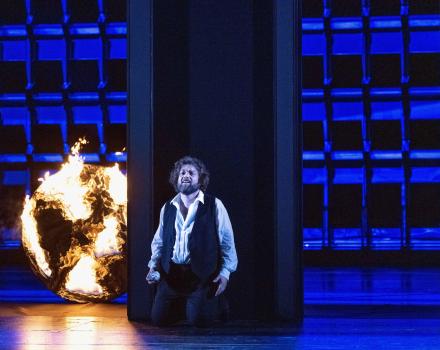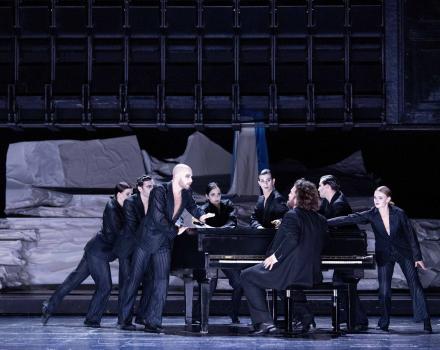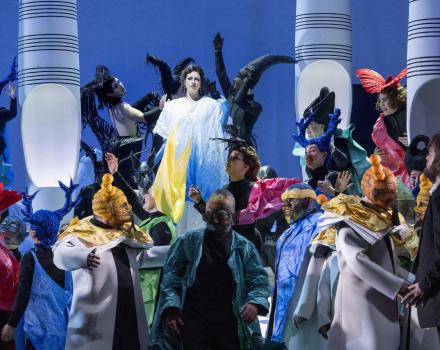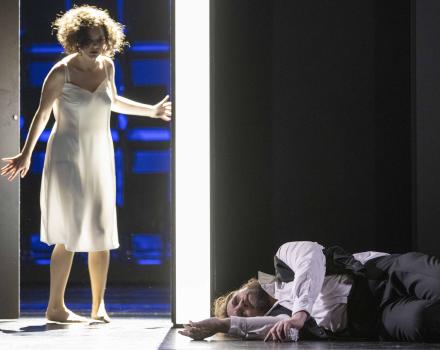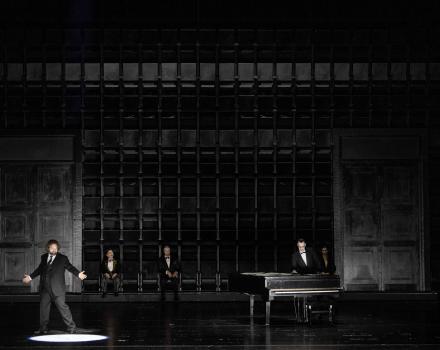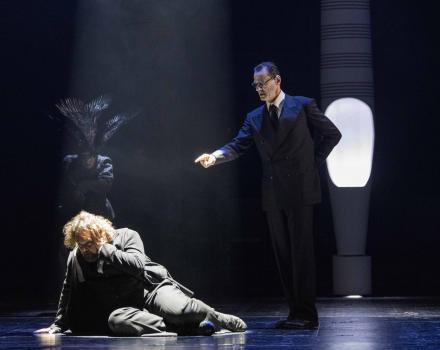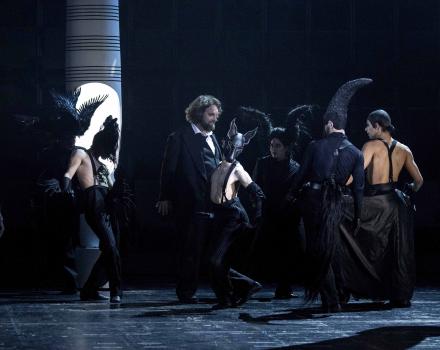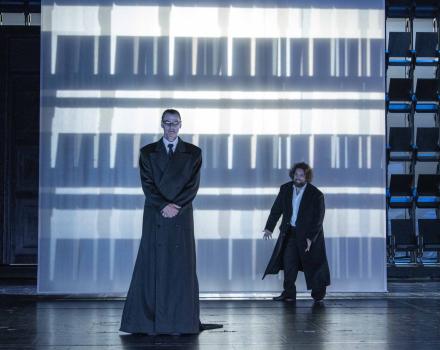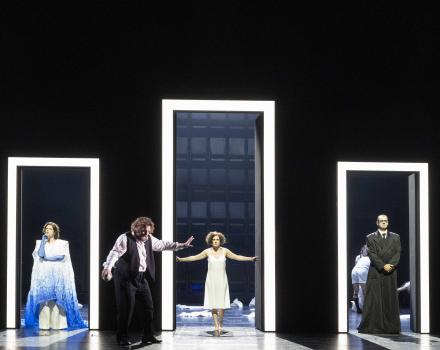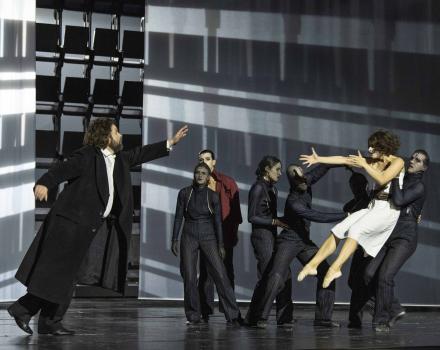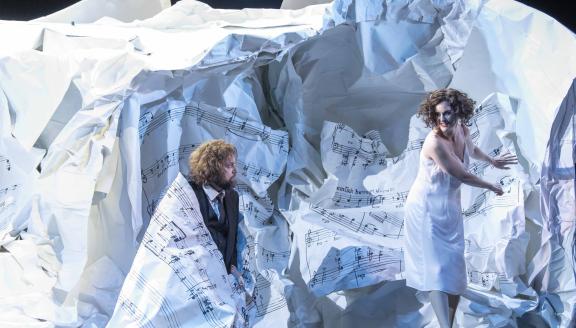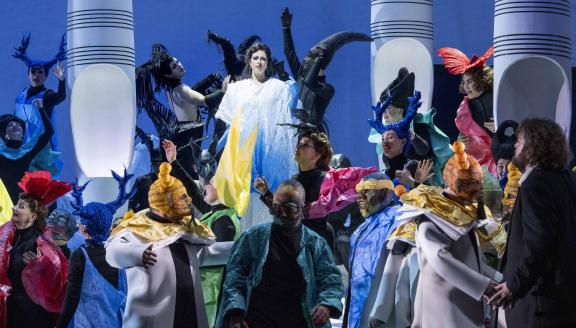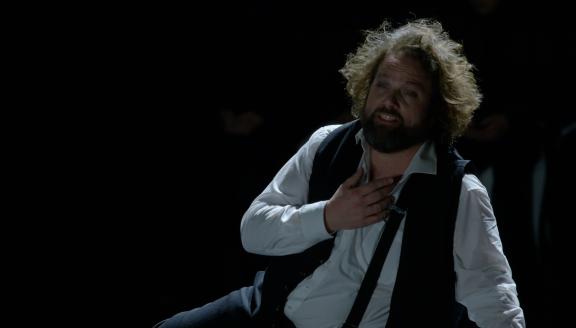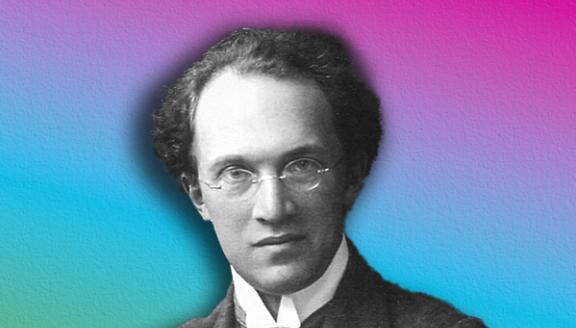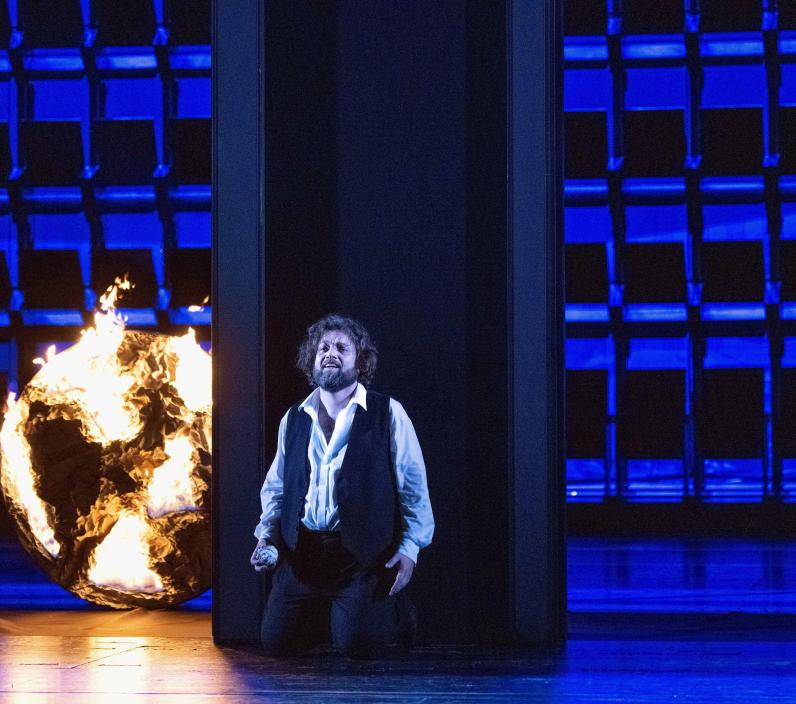
The Singing Devil

Amandus completes the construction of a magic organ just before a pagan attack on the monastery. The instrument’s heavenly sound pacifies the attackers, who lay down their weapons and kneel. But it won’t be long before the tones of this ‘singing devil’ resound again, this time from behind the burning walls of the monastery…
In the beginning of the 20th century, Austrian composer Franz Schreker was one of the only opera composers in the German-speaking world whose success could compete with Richard Strauss. But as of 1933, Schreker’s works were banned in Germany and began to disappear from the international repertoire. Only very slowly did Franz Schreker’s operas come back to the stages, and despite this revival, Der singende Teufel (The Singing Devil) has remained in the shadows to this day. After the streams of Der ferne Klang and Der Schmied von Gent on OperaVision, Theater Bonn’s production is another opportunity to rediscover Schreker’s post-romantic music.
Cast
|
Amandus Herz
|
Mirko Roschkowski
|
|---|---|
|
Lilian
|
Anne-Fleur Werner
|
|
Father Kaleidos
|
Tobias Schabel
|
|
Alardis
|
Dshamilja Kaiser
|
|
The Knight Sinbrand von Fraß
|
Pavel Kudinov
|
|
The Pilgrim
|
Carl Rumstadt
|
|
Lenzmar
|
Tae Hwan Yun
|
|
Abbot
|
Boris Beletskiy
|
|
First Student
|
Ava Gesell
|
|
Second Student
|
Alicia Grünwald
|
|
First Lay Brother
|
Wooseok Shim
|
|
Second Lay Brother
|
Hyoungjoo Yun
|
|
Orchestra
|
Beethoven Orchester Bonn
|
|
Chorus
|
Chorus and extra chorus Theater Bonn
|
| ... | |
|
Music
|
Franz Schreker
|
|---|---|
|
Text
|
Franz Schreker
|
|
Conductor
|
Dirk Kaftan
|
|
Director
|
Julia Burbach
|
|
Sets and costumes
|
Dirk Hofacker
|
|
Light
|
Max Karbe
|
|
Choreographer
|
Cameron McMillan
|
|
Chorus master
|
Marco Medved
|
|
Dramaturg
|
Andreas K. W. Meyer
|
| ... | |
Videos
Story
ACT I
Amandus' room: Amandus successfully built a small organ. Father Kaleidos thinks this is a good time to persuade Amandus to complete the construction of the giant organ that his father had started. Shocked by the proposition, Amandus asks for time to think it over, since he has found out that his father failed to complete this organ due to progressing madness and subsequent death by fire.
Priestess Alardis’ cave: Pagans are looking for the most beautiful maiden for the spring ritual: Lilian is selected to consecrate herself to the one who will lead the pagans against the Christian clerics.
Night: Lilian tries in vain to win Amandus as the leader of the pagans.
ACT II
Amandus' father's former workshop: Tormented by his failure to finish the work on the giant organ, Amandus nevertheless refuses to accept Kaleidos' support. As Amandus hears the first sounds of pagan rituals, he rushes outside to follow the pagan procession.
Moonlit night at the edge of the forest: At the solstice festival, Alardis proclaims a religion of nature and mocks the Christian priests. As the people at the gathering get into a wilder mood, Amandus tries taking Lilian away from this place but the crowd starts making fun of him and he fails. A knight named Sinbrand overpowers him in a duel, has him tied up and abducts Lilian. Father Kaleidos finds Amandus and brings him back to the monastery where he becomes a monk.
ACT III
Cloister in the monastery: Amandus has finally completed the organ. Still, Kaleidos does not grant him peace: Now he is to use the organ to overpower the plundering pagans with the help of the word of God.
Garden in the monastery: Lilian, scarred by the terrible experience of being Sinbrand’s captive, warns Amandus of the upcoming pagan attack. In panic, Amandus calls the monks together to defend the monastery. Amandus has a vision that the sound of the organ will hold the mad crowd away. At first Amandus' vision comes true, but then the new ‘gentle’ pipes of his organ fail. His music breaks off in dissonant chords and the crowd storms the monastery in a destructive rage.
ACT IV
Forest clearing outside Alardis' cave, four weeks later: Lilian helps Amandus to recover. A Moorish pilgrim visits him to ask for help with his broken little organ. Lilian does not want to let the pilgrim see Amandus. Indeed, as soon as Amandus sees the little organ, his memories of his failed life's work are awakened with terrible force. In order to free her lover from this burden, Lilian sees only one way out: to destroy the object that fills him with tormenting horror. She hurries away. Soon Amandus hears the shocking news that Lilian set fire to the monastery, and in the flames the glowing organ started producing delicate heavenly sounds.
Square in front of the burnt-down monastery: Amandus meets Lilian, who is now transfigured blossoming in beauty. Knowing that she managed to break the spell on Amandus, she collapses dead.
INSIGHTS
Director Julia Burbach in conversation with researcher Barbara Dallheimer
Staging Franz Schreker is a challenge in itself! What motivated you to take on Der singende Teufel - first performed in 1928 and last seen on a German stage in 1989?
Thanks to dramaturg Andreas K. W. Meyer(✝) that I ventured into a ‘Schreker adventure’: He practically dropped this challenge into my lap! I'm still very touched that he trusted me to direct this production. I then began to feel my way into the piece and build a connection. I find the relationship that a director enters with a ‘demanding’ piece particularly interesting, because in the search for a meaningful thread with such a work, one often thinks in a more unusual or creative way.
How did you prepare for the work?
I like to take a multi-layered approach at the start of a production. I deal with the music, of course, because this is the framework or subtext of the piece, so to speak; all the solutions are always contained in the music. This raises for me the question as to which solution or path I may choose. Then, of course, I also devote myself to the story itself. I take into account the time in which the piece was created as well as the relationship it might bear with the present day. ‘What is it actually about?’ and ‘What do I want to express with the production?’ are the central questions that guide me.
What was your approach to the story? Is it the religious aspect and the conflict between Christianity and paganism? Or do you focus more on the psychological and humanistic aspect?
At the first glance, the libretto contains a conflict between two religions and we find ourselves within a medieval battle. However, a conflict between the two religious groups is always present in any period of history. I wanted to find an abstraction to take the story out of the Middle Ages and create a framework in which two forces simply clash. Furthermore, I associate the protagonist Amandus Herz very specifically with Franz Schreker. Schreker, the artist and man with Jewish ancestry, found himself within an intrinsic political conflict of his time. He lived in a world in which he had ultimately lost everything. He went all the way from being a celebrated composer to an expelled, persecuted and forgotten artist. This personal fate touched me deeply.
The motive of the (failed) artist runs through several Schreker operas. Now, you also place the composer himself in this context - where do you see his failure?
On the one hand, Franz Schreker ‘failed’ as a Jewish artist due to political circumstances. But he also failed with Der singende Teufel. The critics were no longer favorably disposed towards him at the time - in the late 1920s. And you realise that the opera was no longer as popular as his earlier works. Perhaps, I thought to myself, this was also because he had taken up a religious topic that didn't really suit him. So I decided to tell the story about an artist. An artist who had a difficult relationship with the subject matter of his work, with his time, with his audience and the critics. It is an exciting aspect for me to shed light on – the relationship between the artist and the so-called ‘outside voices’. In this specific case, it made me realise that Der singende Teufel has a lot to do with the life of the composer himself who was caught between contradictions and outside forces. Just as the organ is instrumentalised in the piece as a weapon, the same applies to a work of art in general - in this case to Schreker's operas. As soon as the work is finished, opinions are formed, it is criticised, it is used and misused, it develops a life of its own and to a certain extent gets out of control.
Der singende Teufel, Der ferne Klang or Das Spielwerk - in Schreker's operas, fortunes are often steered by something abstract, perhaps intangible. How do you interpret Der singende Teufel? Is the giant organ the secret protagonist?
It's always good to have an overarching protagonist that you can't see! The audience can identify with the mystery in a different way; the audience can interpret something else into a vacuum or an open space. Nothing is as good as the viewer's imagination!
Gallery
